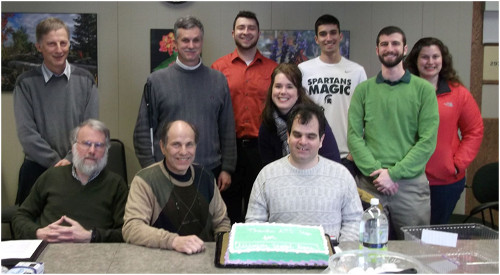Meeting Minutes: March 20, 2014
Present
- Stephen Blosser, Chair
- Graham Pierce, Vice Chair; Webmaster
- Al Puzzuoli, Digital Communications Coordinator
- Michael Hudson
- Connor Moul
- Don Ries
- Madeline Roe
- Angela Sebald
- Tyler Smeltekop
- James White

ATC members celebrating Al Puzzuoli's recognition by the MSU President's office (for his efforts to make digital signs accessible) with a green and white chocolate cake.
Minutes
- Blosser called meeting to order at 3:00 PM
- Al Puzzuoli described the basics of the Morrill Plaza kiosk project.
- President Simon acknowledged the need to provide information presented by the kiosk to visually impaired individuals, and asked Al for assistance.
- After the Morrill Hall team met with the President, they were able to rebuild the sign to make it accessible to visually impaired individuals within 4 days.
- Growth of similar digital signs is likely to continue across campus.
- It is our mission to guide MSU sign builders on issues related to accessibility.
- Blosser elaborated on some specific features of digital signs, including accessibility, software, and features.
- Michael Hudson discussed a well-designed ATM from MSUFCU
- Headphone jack is used for text-to-speech, and triggers an entirely different accessibility mode.
- Users navigate via keyboard, and the audio describes the layout of it.
- Accessibility considerations needed to make digital sign useful to all individuals:
- Color Contrast
- 5:1 contrast ratio or greater for text against background
- Glare is an important factor, whether outdoors or indoors
- Graham Pierce noted that voting systems use hoods or other external measures to reduce or eliminate glare.
- Pierce also discussed impending significant changes in Section 508 guidelines and recommended providing draft guidelines until these changes are official.
- Flicker
- Multimedia
- Height and Reachability
- Color Contrast
- Michael Hudson discussed a well-designed ATM from MSUFCU
- Mobile alternative access discussed for accessing digital signs using smart phones/computers.
- Bluetooth beacon in sign can project its URL to smartphones.
- Puzzuoli pointed out that a mirrored site might not be the best idea, as situations may arise where the sign is updated, but the mirrored site is not. Pierce agreed that mirrored site isn't ideal.
- Pierce suggested clearly stating which mobile alternative access features are required and which ones are merely optional.
- Location of QR code and other features that can be controlled should be regulated, while other features may have to vary from kiosk to kiosk.
- Accessibility Mode button discussed. Instead of having all accessibility features on the physical kiosk, on-screen buttons can be used.
- Blosser discussed non-interactive signs, and what can be done to these signs to make them accessible, including headphone jack & speaker, volume control, etc.
- Pierce stated that these should be stated as required, to ensure that these features are used, and used correctly.
- Bluetooth headphones could not be used in place of a headphone jack, as a Bluetooth earpiece or other similar device would need to be paired before use.
- Pierce suggested that some of these guidelines should be applied to all signs (i.e., including paper signs and posters), especially in areas such as text size and background contrast.
- The meeting was adjourned (Pierce) at 4:10 PM
Respectfully submitted,
Connor Moul, Recording Secretary

